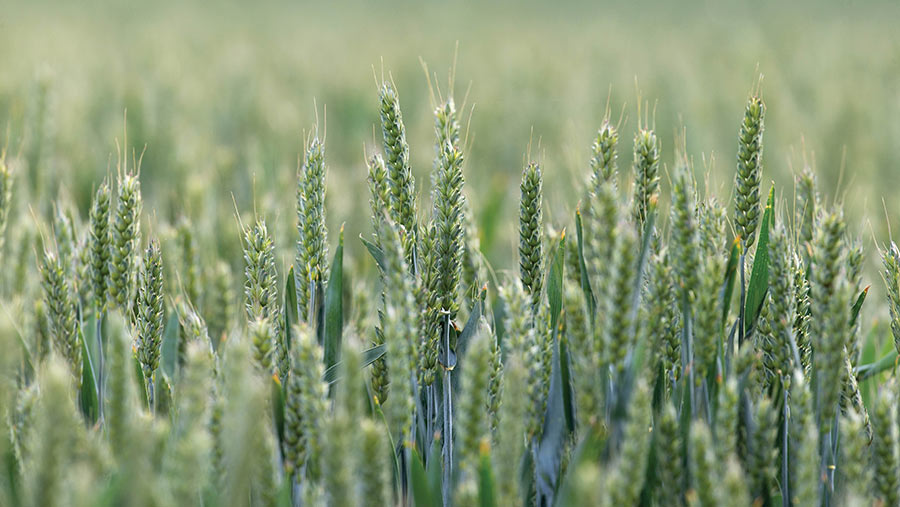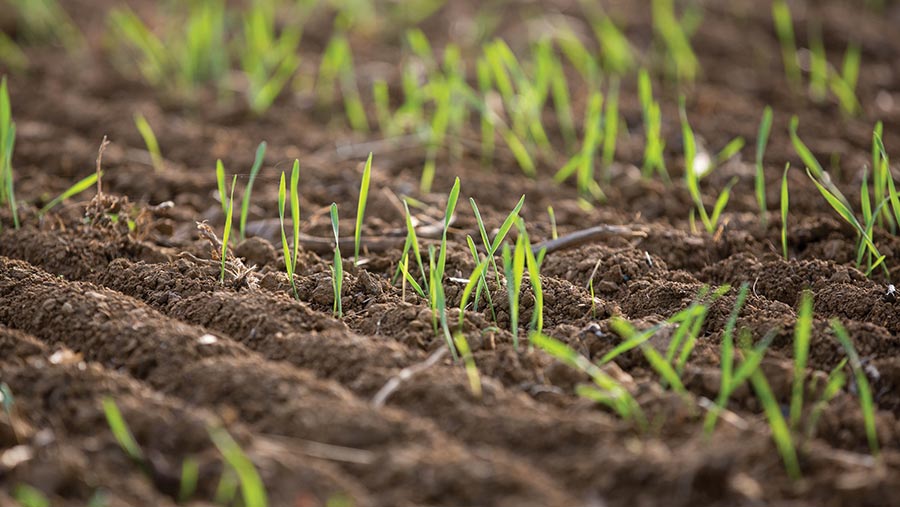How to assess wheat yield potential in-season
 © Tim Scrivener
© Tim Scrivener Assessing wheat yield potential during the season has always been an educated guess at best, based on previous experience, how the crop is looking and past, present and likely future weather. But what if doing some simple crop monitoring through the season could make that assessment a bit more accurate?
That’s what AHDB Cereal Strategic Farm East host Brian Barker has been doing over the past few seasons, with some success, allowing him to farm more to potential rather than hope.
See also: Tips to minimise potato storage losses without CIPC
“My aim is to get out to every field to benchmark them against each other. This gives me insights into which fields, varieties, soil types, establishment methods and seed rates are performing.”
He has learned over time how to adapt his investment in inputs, and also benchmark crops not just in the current season, but also against previous seasons to learn how they responded to certain events, such as dry spells.
So what measurements does he take, and how does he use them to assess yield potential?
What tools do you need to measure crops?
- Ruler
- Quadrat
- Spreadsheet
- Knee pads (optional)
- Patience
Growth guide
The starting point is the AHDB Wheat Growth Guide, he says, which includes benchmarks for counts at different growth stages for an 11t/ha crop. He uses those to understand what to measure, and how to convert to a yield potential.
“In the beginning there are lots of assumptions you make, but at each assessment you’re removing one of those assumptions, so my estimated yield becomes more accurate over time,” Mr Barker says.
Assessments start after establishment, and continue through to harvest (see “What to measure and when in the growing season”) – each time using the measurements and the growth guide benchmarks to estimate yield on each field.

© Tim Scrivener
He has found the best way of getting the most reliable figure is to average the yield estimate from each assessment for each field through the season, rather than looking at the individual estimates.
“Over the four years, this approach has given me a close correlation between what we’ve taken off the field and the average of the estimates, particularly when corrected for the actual thousand grain weight from the combine. Last year, over my whole wheat crop I was within 2% of the actual yield, although this season’s conditions have made it much more difficult to assess.”
Ranking fields
Perhaps the most important step in making practical use of the information is ranking each field throughout the season, and broadly categorising fields into good, average and poor.
Mr Barker then adapt inputs to what he is seeing in the field. “You start finding that the really poor crops get to the bottom quite quickly. Those are the ones where you try to stimulate more growth earlier in the season through fertiliser applications, micronutrients or biostimulants to bring them up.
How to measure and convert
For most counts, it’s possible to either use a quadrat or count a certain length of row, and then convert into square metres. Usually it makes sense to repeat counts a number of times across the field to get a representative picture. For grains/ear, Brian Barker advises counting about 15 ears/sample.
To convert row lengths into plants/sq m, use the following calculation:
1. Count length x drill coulter width = area counted (sq cm)
2. Area in 1sq m (10,000 sq cm) / area counted (sq cm) = multiplication factor
3. Average count x multiplication factor = number of plants/sqm
Example:
1. 30cm count length x 20cm drill coulter width = 600sq cm
2. 10,000sq cm / 600sq cm = 16.67
3. 18 plants (average number from field) x 16.67 = 300 plants/sq m
“Further down the line, you start adapting your inputs more in the field, using your instincts to know when all hope of 10t/ha is gone and you need to think about how to make a profitable 8t/ha crop. Then you can rein back fertiliser or inputs so your cost of production doesn’t run away with you and you don’t try to buy back yield.”
He says it’s about knowing when to turn off the input tap to make sure he is actually getting a profit from every field. “Using this method has given me a lot of confidence in knowing how to invest and budget in my crops.”
Helping with planning and assessing new systems
The data is helpful for making planning decisions or assessing new systems, Brian Barker says.
Analysing data has shown on average he has around 20% losses at establishment, which he can use to adjust seed rates. But it’s also possible to drill down in the data to make adjustments based on previous experiences for particular fields or varieties, different drills, or conditions such as very wet or dry periods.
For example, in a previous season one field had been established in very wet conditions with establishment losses of 45-50%, he says. “So when we faced similar conditions this autumn I knew we had to increase our seed rates to make sure we had a chance of getting the right number of plants for this year.”
It can also help assess benefits in changes of system. “If you’re trying a new drill, assess these fields with as much detail as possible because this is going to help with your decision-making in the future.”
What to measure and when in the growing season |
||||
|
Growth phase |
What to measure |
AHDB benchmarks |
When |
Potential insights |
|
Establishment |
Total plants/sq m |
340 plants/sq m |
About 15 days after emergence (one to two true leaves) |
Establishment percentage – potential to use to adjust seed rates in future years.
|
|
Winter survival |
Total plants or shoots/sq m |
260 plants/sq m (February) or 941 shoots/sq m (GS30) |
End of February and early April (GS30) |
Effects of autumn/winter weather |
|
Tiller survival |
Total tillers/sq m |
902 tillers/sq m (GS31) |
GS31 (mid-April) and GS39 (mid-May) |
Able to adjust inputs based on likely performance of fields |
|
Ear counts |
Ears/sq m |
460 ears/sq m |
GS61 (early June) |
Comparison of major and minor ear numbers |
|
Grains counts |
Grains/ear |
48 grains/ear |
Pre-harvest (July) |
Final assessment of yield pre-harvest
|
|
Harvest |
Thousand grain weight |
50mg/grain = 50g/1,000 grains |
Harvest (August) |
Use thousand grain weight to correct previous figures |
How to convert to yield potential
The benchmark from the AHDB growth guide for a 11t/ha crop at 15% moisture content is 460 ears/sq m, with 48 grains/ear having an average weight of 50mg/grain. Late in the season it is relatively easy to convert to a yield potential by using the following calculation:
Ears/sq m x grains/ear x thousand grain weight (g/1,000 grains) x (10,000/1,000,000,000) to convert into t/ha. Where you don’t have the figure, use the assumption from the growth guide. One possible exception is using the thousand grain weight of the drilled crop, as Mr Barker has found that to be a better guide.
Example: 460 ears/sq m x 48 grains/ear = (22,080 grains/sq m x 50mg/grain) = (1,104,000g/sq m yield x 10,000/1,000,000) = 11.04 t/ha
So, if your ear count was 480/sq m, this would indicate a potential yield of 11.52 t/ha. But if your subsequent average grains/ear was only 42, the yield potential would reduce to 10.08 t/ha.
Before you know the number of ears, it is a matter of making assumptions about the likely final ear count, before using the benchmarks to estimate yield. Again, you can use the benchmarks from the growth guide to help.
If you are aiming for 260 plants/sq m established after winter as per the guide, you can use seed rate calculators to help you initially calculate required seed rates, and the initial establishment count will help you understand germination percentage. By the end of February, benchmark establishment is 70%.
Using the benchmarks, working backwards from 460 ears/sq m, about 51% of the 902 tillers at GS31 become fertile ears, while each overwintered plant produces 3.47 tillers. So you can use those figures to help calculate the likely number of ears post-winter.
Example: 260 plants/sq m x 3.47 = 902 shoots/sq m (at GS31). A 51% survival gives you 460 ears/sq m (x 0.51), and then use the calculation above to get to yield potential.
So, 270 established plants/sq m in February would indicate a 11.47 t/ha yield potential.
There are obvious inaccuracies in using the assumptions, as they are not independent of each other – for example, more plants will likely reduce tiller numbers, but a greater percentage survive to become fertile ears, while more ears could reduce grains/ear.
Equally, repeating the assessments over time in different fields, varieties and seasons can allow you to get a better feel for how different counts affect those assumptions and the final yield potential. This will allow you to make your own adjustments to the calculation.

